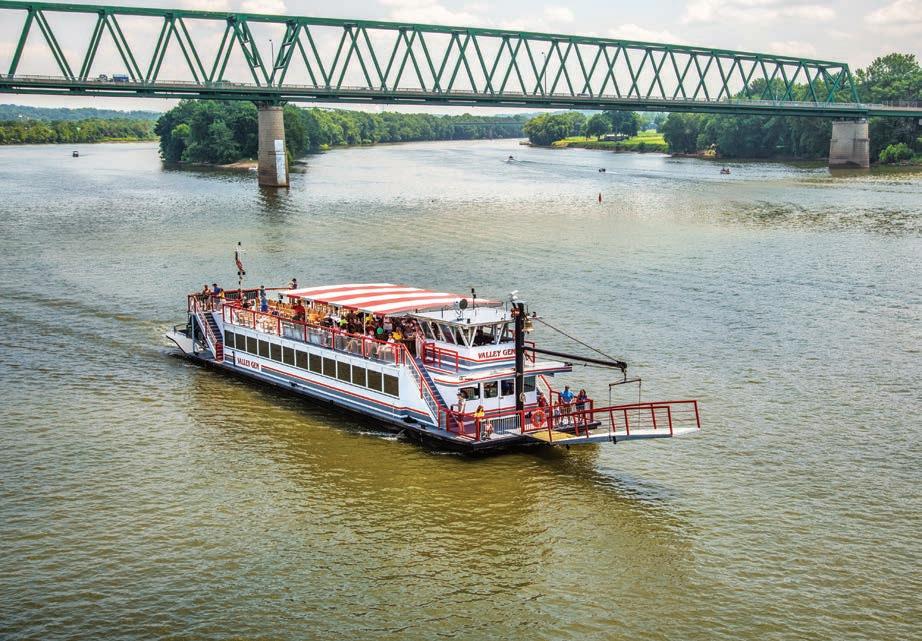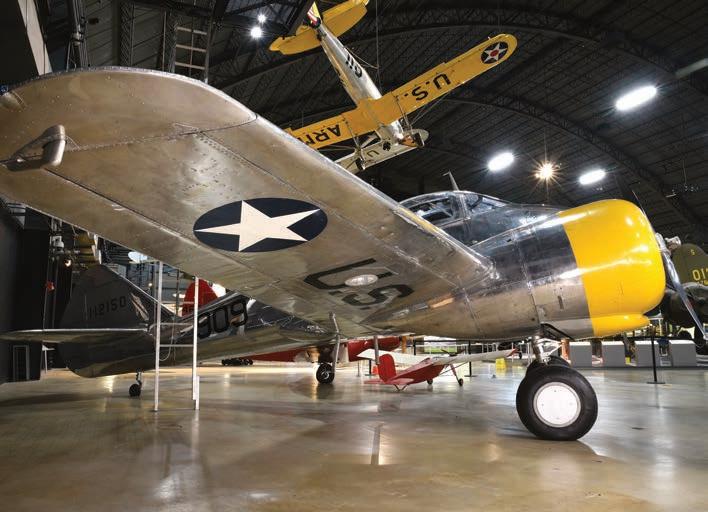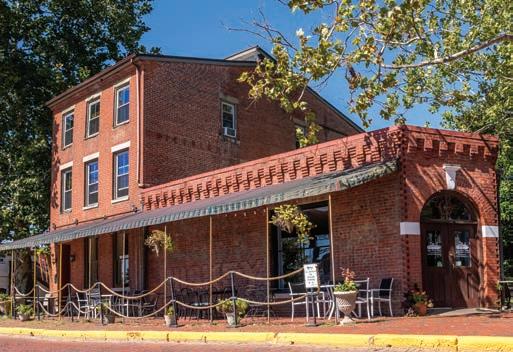
6 minute read
Cincinnati, p. 33, 34
History Lesson
Take a trip into the past in Marietta, the first permanent settlement in the Northwest Territory.
VALLEY GEM STERNWHEELER: Enjoy an afternoon afloat by booking a trip on the Valley Gem, a modern sternwheeler that recalls the romantic heyday of riverboat travel. James and Peggy Sands began offering trips up down the Ohio and Muskingum rivers in 1989, and their operation remains a family business today. Whether you prefer a 90-minute narrated sightseeing tour, a themed dinner cruise or a longer excursion that lasts all day, no visit to this river town is complete without spending some time on the water. 601 Front St., Marietta 45750, 740/373-7862, valleygemsternwheeler.com The end of the American Revolutionary War brought opportunity west of the Ohio River. In 1788, a band of men known as the Ohio Company traveled to the frontier to set up a land office. They called the place Marietta in honor of French queen Marie-Antoinette, whose nation provided help in the battle for independence. Today, this river town’s long and rich history makes for a great day of exploring.
CAMPUS MARTIUS MUSEUM:
Located on the site of the stockade that the Ohio Company built for protection between 1788 and 1791, this museum tells the story of those who lived here through a variety of interesting artifacts and exhibits. Don’t miss the guided tours of the Rufus Putnam House, which still stands within the walls of the museum, to get a true glimpse of what life was like along the Ohio frontier. The original Ohio Company Land Office is also located on the museum’s grounds. 601 Second St., Marietta 45750, 740/3733750, mariettamuseums.org LAFAYETTE HOTEL: In 1892, the four-story Bellevue Hotel rose along Front Street near the banks of the Ohio River, boasting such luxuries as 55 steam-heated rooms, call buttons and hot (or cold) baths. A fire destroyed the place in 1916, but a local businessman rebuilt and reopened the property two years later as the Lafayette Hotel (named in honor of an 1825 visit to Marietta by France’s Marquis de Lafayette). The classic hotel retains a historic feel in its 77 guest rooms, while offering an on-site restaurant and modern amenities that travelers expect. 101 Front St., Marietta 45750, 740/371-7035, lafayettehotel.com

THE LEVEE HOUSE BISTRO: There is just one riverfront structure original to Marietta still standing, and you’ll find it along Ohio Street. Previously serving as a dry goods store, hotel, tavern and restaurant, the property — built sometime around 1826 — is today known as The Levee House Bistro. Reserve a table in the dining room or enjoy a meal on the small patio that offers a view of the Ohio River. Lunch offerings span sandwiches, burgers, flatbreads and salads, while the dinner menu features entrees such as crab cakes and pork chops. 127 Ohio St., Marietta 45750, 740/371-7035, leveehousebistro.com


MOUND CEMETERY: Marietta’s founders dedicated this cemetery in 1801 to protect the Great Mound (or Conus), a 30-foot-high earthwork that Native Americans built more than 2,000 years ago. Today, the Great Mound is surrounded by graves that help tell the city’s story. Gen. Rufus Putnam, the leader of the Ohio Company, is buried here, along with three dozen other veterans of the American Revolutionary War. (It is believed more officers of that war are interred here than any other cemetery in the country.) Located at the intersection of Scammel and Fifth streets, Marietta 45750
Military Tributes
These museums and memorials across Ohio honor those who gave of themselves to protect the United States of America.
National Museum of the U.S. Air Force,
Dayton: This sprawling museum preserves and shares the history of the U.S. Air Force in four hangars that house aircraft spanning from flight’s earliest years to present day. See the famous World War II B-17 F Memphis Belle and the plane that served as Air Force One for President John F. Kennedy and others who held our nation’s top office. 1100 Spaatz St., Wright-Patterson AFB 45433, 937/255-3286, nationalmuseum.af.mil
Soldiers’ & Sailors’ Monument, Cleveland:
The 125-foot-tall Soldiers’ and Sailors’ Monument lists the names of Cuyahoga County’s 9,000 Civil War veterans in its Memorial Room. Four relief sculptures trace the war’s progression. One depicts Abraham Lincoln unshackling an enslaved man and offering him a gun to fight. Another shows Ohio’s famous Civil War generals and war-time governors. 3 Public Square, Cleveland 44114, 216/621-3710, soldiersandsailors.com
National Veterans Memorial and Museum,
Columbus: Focusing on stories over artifacts, this destination pays tribute to our men and women in uniform. Exhibits offer insight into the shared military experience and tell the stories of veterans in their own words. A memorial grove and an upstairs space with multicolored windows inspired by the colors of military service ribbons offer places for reflection. 300 W. Broad St., Columbus 43215, 888/987-6866, nationalvmm.org
Perry’s Victory & International Peace
Memorial, Put-in-Bay: In September

1813, Commodore Oliver Hazard Perry led the United States to one of the most pivotal victories in the War of 1812 near South Bass Island. Today, the Battle of Lake Erie and the lasting peace between the U.S., Great Britain and Canada ever since is remembered with a 352-foot Doric column at this National Park Service site. 93 Delaware Ave., Put-in-Bay 43456, 419/285-2184, nps.gov/pevi
Motts Military Museum, Groveport:
Warren Motts started with collecting Civil War artifacts, a passion that in 1987 prompted him to begin accepting donations for a military museum located at his home. In 1999, he moved the museum to a former garden center and constructed a second wing in 2006. Today, it tells the stories of the military from the colonial era to present day. 5075 S. Hamilton Rd., Groveport 43125, 614/836-1500, mottsmilitarymuseum.org
Classic Cincy
AMERICAN SIGN MUSEUM: A former clothing factory now hosts a colorful collection that encompasses nearly 100 years of signs. See a 3,800-pound, single-arch McDonald’s sign featuring the 1960s character “Speedee” and highlighting 15-cent hamburgers. Then, visit the museum’s glowing “Main Street” room depicting a downtown of years past, when many businesses had electric or neon signs. An afternoon spent here offers a trip through advertising history, as the oldest treasures on display date back to before 1880. Visitors can choose to do a self-guided tour or reserve a private group tour. 1330 Monmouth Ave., Cincinnati 45225, 513/541-6366, americansignmuseum.org From food to baseball to amusement park thrills, these Cincinnati spots offer fun ways to revisit the past.

Cincinnati has been referred to as the Queen City since its 1819 incorporation, as locals hoped to frame it as a place of culture in the still relatively young state of Ohio. Today, visitors will find history everywhere, from the city’s instantly recognizable architecture like Union Terminal and the Roebling Suspension Bridge to its food traditions such as Cincinnati chili and goetta.
FINDLAY MARKET: Ohio’s oldest public market is a fixture of Cincinnati’s Over-the-Rhine neighborhood. The market was originally built as an open-sided pavilion in 1852, and its iron frame construction still visible today hearkens that earlier era. (The market was enclosed soon after the turn of the 20th century and added to the National Register of Historic Places in 1972.) The more than 65 vendors that operate here every day except Monday are a mix of legacy merchants and food entrepreneurs. Renovations made in the early 2000s added a farmers market pavilion. 1801 Race St., Cincinnati 45202, 513/6654839, findlaymarket.org










